Game of Thrones Nights Watch Burial Prayer and We Will Never See Their Like Again
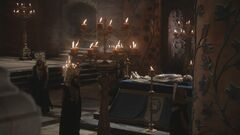
Silent sisters prepare Jon Arryn for his funeral.
- "The tradition of funeral rite. Proper burial in the Temple of the Graces."
- ―Hizdahr zo Loraq pleads that Daenerys Targaryen allow him to recover his executed male parent's body for proper burial.
A funeral is a anniversary to accolade and pay respect to a person who has recently died, and typically involves arrangements for their corpse. Funerary customs are closely tied to religious behavior and practices. Specific funerary practices vary throughout the known globe, and can even vary within regions that follow the same religion.
Burial is the predominant method used in Westeros, by both followers of the Quondam Gods of the Wood and the Organized religion of the 7, though cremation is practiced in certain locations. Meanwhile, cremation seems to exist somewhat more than common in parts of Essos, though burial is also proficient. The ancient Valyrians, (obviously) the Lord of Calorie-free religion, and the Dothraki all burn down their dead on funeral pyres.
Faith of the Seven
In the Seven Kingdoms, the bodies of the dead are tended and prepared by the Silent Sisters, a religious lodge inside the Faith of the 7 devoted to this job. Their monastic club is sworn to service of the Stranger, the attribute of the godhead that represents death and the unknown.
The torso of the deceased is commonly laid in state for visitors and prayers. The body is displayed atop an altar, changed into formal apparel (and if they died violently, their wounds cleaned upwardly as best as possible). The body'south hands are clasped together over the chest, and men's bodies are often laid in state with their easily clasping a sword (pointed downward). In septs which are large plenty to have statues of each of the Seven in a ring around the main chamber, such equally the Swell Sept of Baelor, the body itself is positioned so that the head is pointed towards the statue of the Stranger.
Ii funeral stones are too placed over the airtight eyes of the deceased, each painted to resemble open optics. The symbolic significant of this is to remind the faithful that they should not fear death, because it is not truly the stop: we shut our eyes in this earth, but our eyes open again in the afterlife.[one]
Wealthy adherents such as members of the nobility can afford to have their corpses embalmed, to slow the processes of decay while they are entombed. This process involves removing several internal organs from the corpse, the ones that break down most quickly, and placing them in seven formalism vases - which are then placed nigh the corpse at the funeral ceremony itself (ofttimes at their feet).
There tin be some variation in the Faith's funeral practices, however, even between individual noble Houses, and some traditionally practise cremation. House Tully of Riverrun is a very prominent example, as seen at Hoster Tully'due south funeral. The corpse itself is prepared and laid in country much equally at a typical funeral, with the eye stones and 7 vases, but it is then ceremonially gear up adrift on the Red Fork of the Trident River, in a small boat filled with straw, woods, and oil. Afterwards a member of the funeral party shoots a flaming arrow at the boat from the shore, setting information technology aflame, and thus cremating the corpse. The Trident River waters the lands of Business firm Tully and sustains the lives of its people - life comes from the river, and returns to it.[two] It is unclear if all or even about Houses in the Riverlands also exercise funeral boat cremations like Business firm Tully does.
More than generally, followers of the Faith of the Seven will sometimes resort to cremation if circumstances forestall them from conducting a more thorough burial, i.e. if they are on armed forces entrada and the ground is besides stony to dig, or if in that location are too many corpses to dig graves for, such every bit after major battles or in times of plague.
Members of House Targaryen, despite converting to the Faith of the Seven after acquisition and uniting the 7 Kingdoms, continued to do cremation in the tradition of their Valyrian ancestors. As the royal family unit of the Seven Kingdoms, the ashes of members of House Targaryen were interred at the Slap-up Sept of Baelor in Rex's Landing. Following the autumn of the Targaryen dynasty, the new purple family was expected to follow in their footsteps by having their dead entombed in the Dandy Sept's crypts (though non cremated). King Robert Baratheon, nevertheless, demanded that his remains be sent to his family unit's ancestral seat, Storm's End, to be interred with his forefathers (perhaps also because he hated the Targaryens and didn't want his final resting place to be aslope them).
Valuable servants of the crown sometimes may also exist deemed worthy of being interred at the Bang-up Sept as well. Grand Maester Pycelle expressed his promise that he would live out a long life and at the end of information technology peacefully rot abroad in the crypts under the Great Sept.


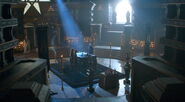
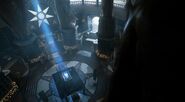
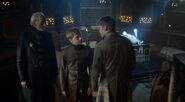
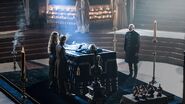
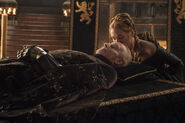
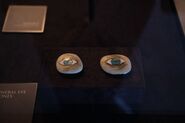
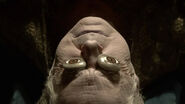
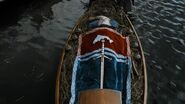
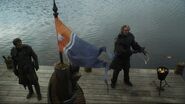
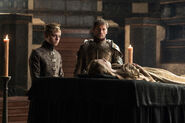
Myrcella prepared for funeral
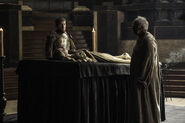
Old Gods of the Woods
Descendants of the First Men who continue to worship the Erstwhile Gods of the Forest mostly seem to prefer to coffin their expressionless. Members of wealthy noble Houses are often buried in extensive tombs. Picayune is known nigh the funeral ceremony itself in their faith, but like their matrimony customs they are probably much more simple than those in the Religion of the Vii.
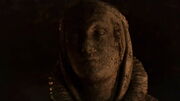
Lyanna Stark'south grave statue in the crypts beneath Winterfell.
Business firm Stark, for instance, buried their dead in an all-encompassing organisation of crypts underneath their castle-seat at Winterfell. Each individual tomb has a rock sculpture placed to a higher place information technology in the likeness of the deceased. The tombs of Stark men are oftentimes left with real swords held by their statues. The Starks have ruled over the North for and so many thousands of years that the crypts underneath Winterfell are truly vast, some say every bit large every bit the castle in a higher place.
The other Northmen likewise seem to predominately bury their expressionless, often in large tombs, some of which are located under big artificial burial mounds (barrows). The North is dotted with many aboriginal barrows, some thousands of years quondam and their owners forgotten - as evidenced by place-names such as the Barrowton in the Barrowlands, the southwest of the Northward which is noted for its large concentration of barrows.
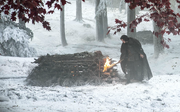
The wildling Ygritte is cremated on a funeral pyre past Jon Snow.
The Free Folk who live beyond the Wall, derisively known as "wildlings", also follow the Old Gods - merely apparently, all of them at present burn their dead. By the War of the V Kings, the wildlings cremate their dead due to the authentic fright that the returning White Walkers can resurrect corpses every bit undead wights. Equally with the Northmen, the funeral isn't conducted with much anniversary - and in this instance seems to be much more than near merely disposing of the body. It is unclear if the wildlings practiced cremation centuries agone, before the return of the White Walkers, or if they always did out of a cultural fearfulness of them which continued to be held for thousands of years. Either way, the wildlings exercise not possess much in the way of skill or resources with stonework to brand tombs similar the Starks did.
The Night's Picket
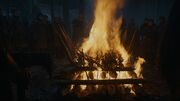
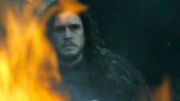
The Nighttime's Watch burn the bodies of their fallen members in funeral pyres. During the ceremony, the highest ranking member present gives a eulogy for the deceased black blood brother. He finishes the eulogy with the traditional line, "and at present his watch is ended", which is then repeated by the gathered audition. The line refers to the sacred vow of the Night's Scout that a member'south watch will not end until his death.
The Sentry apparently holds this non-denominational funeral custom for its members regardless of what their personal religion was, though given that none of the three major religions in Westeros have a prohibition against cremation this doesn't seem to be an upshot.
It seems likely that the Watch'southward tradition of called-for its dead is a holdover from the Long Night thousands of years ago, and that like the wildlings they fire their dead to prevent their corpses from ever beingness turned into wights - though it is unclear if in generations prior to the State of war of the 5 Kings, they remembered that this was the original reason why they exercise cremation.
Maester Aemon was built-in a member of House Targaryen, before later joining the maesters and then the Night's Sentry. His body was burned on a funeral pyre at his funeral, as was fitting not but for a member of the Sentinel but for one of the Targaryen bloodline.
Essos
There are many more numerous and more diverse religions and cultures in Essos than in Westeros, which probably have similarly diverse funeral customs.
The ancient Valyrians burned their dead, oft with dragon-burn. The Lord of Calorie-free religion, the well-nigh widespread religion beyond the Free Cities and several other regions (particularly the southern Free Cities), probably also practices cremation.
The Dothraki mounted hordes (khalasars) from the plains of central Essos also burn their dead on funeral pyres. The Dothraki believe that the stars in the night sky are the fiery khalasar of the Keen Stallion (the horse god which is their primary deity).[3] Burning a Dothraki's body allows his ashes to rise up to the heavens, where his spirit volition join the fiery khalasar of the Great Stallion, and ride with the spirit of his ancestors in the Dark Lands (afterlife).[4] [v] It is considered a terrible dishonor not to burn a dead Dothraki. The prospect of insects and worms eating through their corpse until it decomposes to null but bones is considered quite horrifying to them.[half dozen]
The Ghiscari religion in Slaver's Bay besides has funeral rites conducted at each metropolis's Temple of the Graces, though the details haven't been specified.[7]
Desecration
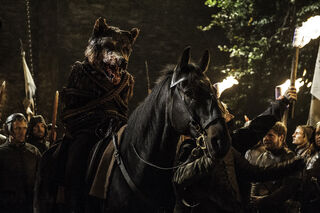
The Freys horrifically desecrate Robb Stark'southward corpse at the Red Wedding, cutting his caput off and sewing his direwolf's caput in its identify.
Desecrating a corpse past denying information technology proper burying is considered a heinous offense in every major organized religion and culture, even if the dead person did not follow the same faith.
Sometimes a corpse can exist desecrated simply past denying it a proper funeral, just simply leaving information technology unburied in the wild to rot and for wild animals to scavenge.
In more farthermost cases, a corpse may exist terribly desecrated by mutilating or dismembering it afterward death.
Putting an executed person'south head on a fasten for public display is not, strictly speaking, considered an act of desecration: with the medieval-level of it in Westeros and Essos, putting a head on brandish is often simply meant to confirm to the public that the executed person is in fact dead. Needlessly harming the body more than that is considered improper, as is leaving a head on a spike until it rots to pieces - long after the point of confirming his death has already been made.
Several notable desecrations include:
- Robb Stark'southward body was horrifically mutilated after he was killed in the betrayal at the Reddish Wedding. His caput was cut off and the caput of his direwolf Grey Wind was crudely sewn in its place by the Freys, who had already violated sacred invitee right by betraying Robb while he was a formal guest at their castle, the Twins (though while Frey crossbowmen severely injured Robb, it was Roose Bolton who dealt the death blow when he stabbed him through the heart). The Freys then triumphantly paraded Robb Stark'southward horrifically mutilated corpse are their castle on a horse while mockingly chanting, "Male monarch in the North! Here he comes, the King in the North!".
- Catelyn Stark'due south corpse was also desecrated in the aftermath of the Reddish Wedding. In direct mockery of House Tully'due south funeral customs, the Freys threw her corpse directly into the Light-green Fork of the Trident exterior of the castle, to rot and be eaten by the fishes.
- Khal Jhaqo mutilated Rakharo's corpse later he killed him, then sent his severed caput back to Daenerys Targaryen on his horse. This acquired Irri to break down crying, explaining that to the Dothraki, leaving a warrior'due south body unburnt is considered sacrilege, but dismembering after death and then leaving the individual pieces to rot is tantamount to killing his very soul.
- Tywin Lannister, as recounted by his daughter Cersei, killed every man, woman, and child of House Reyne at the end of Reyne Rebellion in his youth. He then had their corpses hung on public display in a higher place the gates of Casterly Rock, where they were left all summertime until they rotted to pieces (consider that a "summer" in Westeros can last for years).
- Joffrey Baratheon pushed the already thin line of how long it is tolerable to continue an executed prisoner's caput on a spike when he left the severed head of Eddard Stark on the traitor'southward walk in the Ruby Keep, forth with the rest of his household servants. It stayed in that location rotting for weeks, and one of his son Robb's specific demands sent to the capita (along with recognition of the North's independence) was for his male parent's bones to be returned. Joffrey was uninvolved and Cersei didn't peculiarly intendance, merely Tyrion urged his sister to at to the lowest degree send Eddard's basic back as a gesture of skillful faith. A group of Silent Sisters later accompanied Littlefinger to evangelize Eddard'due south remains to his widow Catelyn while she was meeting with Renly Baratheon in the Stormlands.
- Daenerys Targaryen, after conquering Meereen, had exactly 163 of the defeated Dandy Masters crucified, to pay them back for the 163 slave-children they left crucified on the route leading to the city in an attempt to intimidate her. Some time subsequently, the nobleman Hizdahr zo Loraq sought audience with Daenerys and begged her to allow him to recover his male parent's body and give it a proper burial. Daenerys stated that her intention was to leave all of the corpses crucified until they rotted abroad, as a alert to the surviving erstwhile slave-masters. Hizdahr, yet, somewhen managed to convince her that her point had been made and this desecration was beginning to expect needlessly cruel, so she ordered them taken down.
In the books
In the A Song of Ice and Burn novels, a few more details are given near funeral practices in different parts of the world.
The novels did not specifically mention that members of the nobility in Westeros have their bodies embalmed past removing several vital organs and placing then in seven vases with the corpse (somewhat like mummification). This was introduced in the very showtime episode of the TV series at Jon Arryn's funeral. At Tywin's funeral in the books, however, information technology is mentioned that his corpse was "embalmed" in some traditional fashion to slow its decay, so it seems to have been implied that something like this occurs in the novels. Showrunners Benioff and Weiss might non have been the ones who came up with this thought: in the Blu-ray commentary for the offset episode, they openly express their confusion at what the vases near Jon Arryn'due south corpse are there for.
The Faith of the Seven apparently doesn't have whatever rules against cremation, every bit it was practiced not only by the Targaryens only also the Tullys and several other groups in Westeros. This is in contrast with Christianity in the existent-life Heart Ages, which at times strongly discouraged or even forbid cremation of corpses. This prohibition was due to the strict doctrinal conventionalities at the time that at the Last Sentence, the expressionless would not simply exist resurrected by being "given" new bodies for their spirits, but quite specifically that their original bodies/skeletons would exist restored to life/regenerated from their graves (in times of persecution, the Romans - who practiced cremation - would sometimes cremate dead Christians to taunt this conventionalities). Similarly, in Judaism cremation has historically been frowned upon and in some denominations forbidden, and in Islam information technology is strictly forbidden. No culture has been mentioned in the A Song of Ice and Fire novels that outright opposes cremation.
The Targaryens practice cremation in the tradition of their Valyrian ancestors, though they converted to the Faith of the Seven. When the dragons were all the same alive, their funeral pyres were lit with dragonflame - Aegon the Conqueror'southward funeral pyre was lit past the flames of his own dragon, Balerion. A discrepancy was thought to have arisen in Season iii's "And At present His Picket Is Concluded", when Joffrey Baratheon is giving Margaery Tyrell a bout of the Great Sept of Baelor, and he describes giving her a tour of the crypts beneath where the "remains" of the Targaryens from past centuries are kept. On the one hand, this somewhat implied that their corpses were cached and not cremated, but on the other hand, the novels never actually said what they did with the ashes of the deceased: in real life some people scatter ashes in bodies of h2o or to the current of air, but others permanently store ashes in ceremonial vases kept in mausoleums. The affair was subsequently explained in the World of Ice and Fire sourcebook (2014) which specified that the Targaryens indeed kept the interred ashes of their dead, in vases stored in the Great Sept'south crypts - thus the Tv version did not introduce any discrepancy.
It hasn't been mentioned exactly what funerals are like for the ironborn, who follow the Drowned God - though it seems probable that they conduct burials at sea. Autonomously from the fact that they don't fear drowning and believe that they go to the Drowned God's watery halls when they dice, the Iron Islands themselves have tough rocky soil which probably isn't conducive to burial, and they probably don't cremate their dead either, as it is stated that the isles don't accept major forests so wood is relatively hard to come by too.
The Dothraki are described as burning their dead in the main novels. The Earth of Ice and Fire sourcebook went on to explicate that the Dothraki are opposed to working their own agriculture because they believe that the Earth is their mother, and therefore it is defacing her to plow fields in the ground. It is possible that they cull cremation over burying for like reasons.
No specific details accept been mentioned about what exactly funeral rites are like in the Ghiscari organized religion of Slaver's Bay.
In the Summer Islands religion, funerals are not somber occasions mourning the expressionless just celebrations of the lives they led, with wine and lovemaking.
In the books, desecration of a fallen enemy'due south corpse is thought to be a highly dishonorable and reprehensible action - non quite as bad as regicide or kinslaying, but almost as bad as treason, in some cases worse. Desecrating a corpse by simply leaving it on the battleground for the wolves and crows to consume is considered dishonorable to brainstorm with - actively mutilating a foe'south corpse is drastically worse, the more severe the mutilation the worse the offense.
After Robert Baratheon killed Rhaegar Targaryen in single combat at the Boxing of the Trident, Rhaegar's surviving followers who had been captured (i.due east. Barristan Selmy) begged Robert to let them give Rhaegar'due south corpse a proper funeral - which, afterwards the Valyrian custom of the Targaryens, was to burn his corpse on a pyre. Robert absolutely hated Rhaegar, his mortal enemy, and for years later Robert openly admitted that he fantasized about killing Rhaegar over and over over again in his dreams at nighttime - nonetheless even Robert of all people would not deny Rhaegar a proper funeral, as this would take been a highly dishonorable action.
In Season 3 of the TV serial, it is said that Robert privately wished to accept the Targaryens' remains thrown into the ocean, but the High Septon at the time objected and Robert didn't push the issue. The novels never gave any indication that Robert wanted to do this - however even if Robert didn't feel personally obliged to give Rhaegar a proper funeral, he certainly realized that to really go through with desecrating Rhaegar'south corpse would be seen as publicly disgraceful, and much of the realm would lose respect for him. Thus in both versions, Robert ultimately wouldn't hazard dishonoring himself by desecrating Rhaegar's corpse, fifty-fifty if he was his hated enemy - compared with how in the novels, the Freys seem outright surprised at how insulted and disgusted the residuum of Westeros becomes when word gets out of how they horrifically desecrated Robb Stark's corpse.
Come across also
-
Funeral on Wikipedia
- Nameday
- Marriage
References
- ↑ "The Red Woman"
- ↑ "Walk of Penalization"
- ↑ David J. Peterson's blog, Dothraki.com, April sixteen, 2012
- ↑ "The Night Lands"
- ↑ David J. Peterson's web log, Dothraki.com, April 16, 2012
- ↑ "The Pointy End"
- ↑ "The Laws of Gods and Men"
Game of Thrones Nights Watch Burial Prayer and We Will Never See Their Like Again
Source: https://gameofthrones.fandom.com/wiki/Funeral